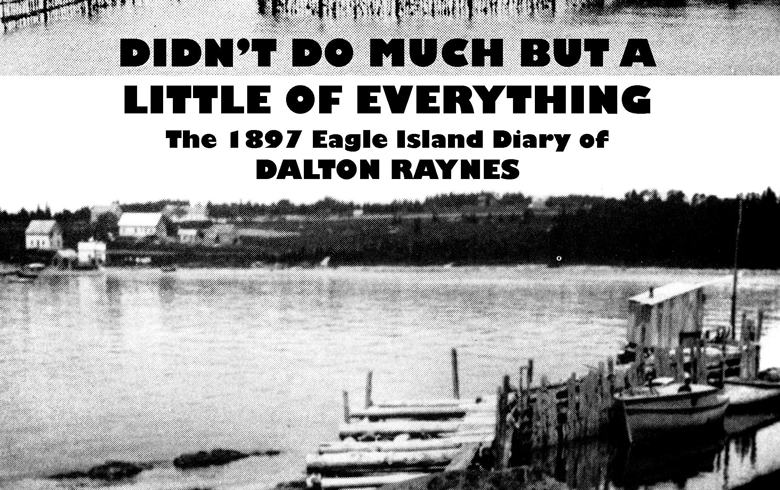Review by Dana Wilde
Didn’t Do Much but a Little of Everything: The Eagle Island Diary of Dalton Raynes
Ian Ludders, ed.; Lulu.com
It’s about 1961, a sunny day somewhere in Scarborough. Spread over what seems, to my 8-year-old eyes, like acres and acres of dry field, are sardine seines. Trapped underneath the seines are millions of grasshoppers hopping and clicking and trying to jump free. Fishermen are sitting on low supports, possibly lobster traps, and pulling the nets onto their laps. They are slowly, garrulously mending the nets.
In 1897, fisherman Dalton “Dal” Raynes, age 19, described this very activity in his diary. While he’s spending the winter in Augusta, his second entry says:
Sat. Jan. 2 Wea. Fine
Went skating & found it quite soft.
Knit about a foot on the seine
I can knit across it in fifteen minutes
It is one inch mesh & fourteen feet long
Ian Ludders, the compiler, editor, and publisher of Didn’t Do Much but a Little of Everything: The Eagle Island Diary of Dalton Raynes, adds in one of his fascinating footnotes to the diary’s scant lines: “Dal has been tasked [by his uncle Edgar Crosby Quinn of Eagle Island] with the winter work of knitting a new seine (a huge net) for the weir [at Wood Landing]. … Cotton twine is spooled onto a ‘needle’ (it looks something like a weaver’s shuttle) and is then looped around a wooden mesh board (like a short, thick ruler) and tied off artfully in knot after knot to form meshes, every one kept carefully true to the measure.”
We were living and breathing the same tidal life as Dal Raynes, and Bernard, and the Wabanakis…
Those needles and twine live clearly in memory. I wanted to learn to work them myself.
I also remember blueberrying in Pownal on brisk late-summer days with a fisherman’s family. Dal recalls it for me:
Sept. 15, 1897, Isle au Haut: “Wea. Fine day / We picked berries all day”; Sept. 16: “Wea. Fine day / We picked berries untill half past three and then went home / We got a bushel of cranberries and black berries”
Ludders’s footnote: “I love these berrying excursions. I can’t help but read them as a Wabanaki cultural practice that’s been carried over, like so many others, into the culture of the state of Maine. Seasonal foraging for storable food.”
I think Ludders is probably right about this, though of course I had no idea in 1961 that I was participating in an ancient traditional practice.
It is unbelievable how full and deep Dal Raynes’s seemingly scant lines go, and how Ludders teases from them “the vast familial spiderweb of 19th century Penobscot Bay.”
A sort of 21st century renaissance man of itinerant occupation, Ludders worked recently as a sternman for Bob Quinn of Eagle Island (northeast of North Haven). Quinn’s stories of island lore prompted Ludders to read Paul Molyneaux’s The Doryman’s Reflection, an autobiographical look at the fishing life and its changes.
Molyneaux fished with Bernard Raynes, the grandson of Dalton Raynes, and Ludders noticed in Molyneaux’s book a mention of a diary kept by Dal at the age of 19. Curious, he contacted Molyneaux, who sent him photocopies of the diary’s pages. Finding them full of cryptically fascinating names, he set about to connect as many dots as he could.
The result is a detailed peripatetic guide to the lives and families of Maine’s Midcoast around the turn of the 20th century. By mining public records, newspapers, books, and people (Raynes’s descendants provided photos), Ludders identifies every family, friend, and neighbor named by Dal, from Eagle Island to Camden to Augusta to Etna, every odd word (Dal sometimes calls lobsters “clawfish”), tracks Dal’s refitting of the sloop Rara Avis, provides the fisherman’s expense ledgers, digresses into the history of canneries, and illuminates the already brewing worries about Canada’s lack of lobster-fishing restrictions that might mean the “extermination” of the clawfish.
Ludders’ ruminative footnotes far outnumber, in words, the diary. His original accomplishment, though, is recognizing the poetry that—probably unintentionally—suffuses every line Dal wrote.
Dal winters in Augusta and sails from island to island in the spring, summer, and fall to fish, transact business, work, and visit. Life’s elements are timeless, and get held dormant, until through some unforeseen prompt, like sketches in a diary or lines of unintentional poetry, memories spout to the surface from underneath, where unbeknownst to you it has been permeating everything.
Fri. Aug. 13 Wea. W. wind
I set out 12 traps
I only got 5 lobsters
When I was 11, a fisherman’s kid and I set our one legal lobster trap off the ledgy shore of Mackerel Cove at Bailey Island. We caught one lobster all summer, and many, many rock crabs. We never called the lobster “clawfish.” But we were living and breathing the same tidal life as Dal Raynes, and Bernard, and Paul, Bob, and Ian, and the Wabanakis in berrying time, and never knew it. Or knew it by the weather, which was everything every day.
Didn’t Do Much but a Little of Everything is a unique evocation of how deep everyday life on the coast is lived.
The book is available at cost through lulu.com or by emailing Ian Ludders at iludders@riseup.net, or by mail at HC2 Box 11 Eagle Island, Sunset, ME 04683.
Dana Wilde, a former editor and college professor, lives in Troy and writes the Backyard Naturalist and Off Radar columns for the centralmaine.com newspapers. He is a member of the National Book Critics Circle.





